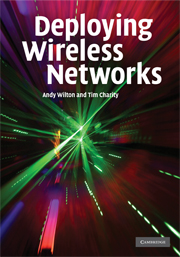Book contents
- Frontmatter
- Contents
- Foreword by Sir David Brown, FREng
- Preface
- Acknowledgements
- Authors' disclaimer
- 1 Introduction
- 2 Wireless network systems
- 3 Principles of access network planning
- 4 Introduction to RAN planning and design
- 5 GSM RAN planning and design
- 6 UMTS RAN planning and design
- 7 Cellular OFDM RAN planning and design
- 8 Mesh network planning and design
- 9 Core network and transmission
- 10 Network operation and optimisation
- Acronyms
- Index
- References
7 - Cellular OFDM RAN planning and design
Published online by Cambridge University Press: 13 August 2009
- Frontmatter
- Contents
- Foreword by Sir David Brown, FREng
- Preface
- Acknowledgements
- Authors' disclaimer
- 1 Introduction
- 2 Wireless network systems
- 3 Principles of access network planning
- 4 Introduction to RAN planning and design
- 5 GSM RAN planning and design
- 6 UMTS RAN planning and design
- 7 Cellular OFDM RAN planning and design
- 8 Mesh network planning and design
- 9 Core network and transmission
- 10 Network operation and optimisation
- Acronyms
- Index
- References
Summary
At the beginning of 2003, results from the first commercial deployments of UMTS were coming in and the inefficiency of Release 99 both spectrally and in terms of its long ‘call’ set-up times were becoming apparent. Coincident with this, Wi-Fi networks were becoming omnipresent in businesses and cities and broadband was achieving significant penetration in homes through much of the developed world. The user expectation was shifting from ‘dial-up’ latencies of tens of seconds to delays of less than 200 ms! These events together made it clear that there was a need for change if operators using 3GPP-based networks were to remain competitive. The requirements for a ‘long-term evolution’ of UMTS can thus be traced to this time when a study, which eventually led to the publication of a document Evolution of 3GPP System [1], commenced. The results from this study made it clear that, in future systems, support of all services should be via a single ‘all IP network’ (AIPN), a fact already recognised in the 3GPP study ‘IP Multimedia Services’ with an initial functionality release in Release 5 (June 2002). What was different, however, was that it also identified that both the core network and access systems needed to be updated or replaced in order to provide a better user experience. Even at this initial stage, control and user plane latencies were itemised as major issues with latencies of <100 ms targeted alongside peak user rates of 100 Mbits/s.
Information
- Type
- Chapter
- Information
- Deploying Wireless Networks , pp. 222 - 263Publisher: Cambridge University PressPrint publication year: 2008
